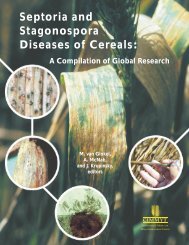Section 3 (Crop Management)
Section 3 (Crop Management)
Section 3 (Crop Management)
You also want an ePaper? Increase the reach of your titles
YUMPU automatically turns print PDFs into web optimized ePapers that Google loves.
Proceedings of the 8 th Asian Regional Maize Workshop, Bangkok, Thailand: August 5-8, 2002<br />
Maize: A Newly Sequential <strong>Crop</strong> with Rice in Thailand<br />
Somchai Boonpradub 1 and Sanayh Kraokaw 2<br />
1 Phitsanulok Field <strong>Crop</strong>s Experiment Station, Phitsanulok 65130, Thailand.<br />
2 Field <strong>Crop</strong>s Research Institute, Bangkok 10900, Thailand.<br />
Abstract<br />
Maize is one of the dry land crops grown in a rice-based cropping system. However, its productivity<br />
has been often limited by major management constraints focusing on cultivars and cultural management.<br />
A series of field studies have been conducted since 1998 to study the productivity of maize grown after<br />
rice. It was found that maize grown after rice showed more income and profit as compared to the second<br />
rice. The best planting time for maize after rice was from November to December. After harvesting rice<br />
the land was plowed, harrowed and fertilized with 50-62.5-0 kg of N-P2O5-K2O ha -1 . Hybrid seeds mainly<br />
from single cross hybrids were planted with 0.75 x 0.20 m spacing with 1 plant hill -1 (66,666 plants ha -1 ).<br />
Three weeks after planting, urea (46-0-0) at the rate of 156 kg ha -1 was applied as a top-dressing fertilizer.<br />
To increase maize production in the paddy field, it was necessary to provide adequate water as applied by<br />
furrow-irrigation for its growth. The results also show that the yields of maize under recommended<br />
practices were generally greater than those of the farmers’ ones. It is rather obvious that maize after rice<br />
may be one of the alternatives cropping systems for rice farmers to intensify cropping on their lands<br />
during a dry season in Thailand.<br />
Introduction<br />
In the area where irrigation water is available during a dry season, after the main rice is harvested, it<br />
is soon possible to plant upland crops. The attendant factors with the post-rice environment are<br />
waterlogging and cool temperature at early vegetative stage, drought and high temperature at reproductive<br />
stage, poor soil granulation and soil compaction including short photoperiod (Boonpradub et al., 1998;<br />
Lantican, 1982). Thus, the desirable characters of upland crops for the post-rice are drought tolerance,<br />
waterlogging tolerance, early to medium maturity, photoperiod insensitive, early and rapid seedling<br />
development, tolerance to low and high temperature (Navarro, 1986). Some of the crops that are suited to<br />
this condition are soybean, mungbean (Gomez and Gomez, 1983) and maize (Lantin, 1986).<br />
The most popular cropping systems in Thailand are cereal – legume, i.e. rice – soybean, rice – peanut<br />
and rice – mungbean. Two-crop systems involving legumes are common in irrigated areas and the ricerice-rice<br />
system is becoming widespread because of the promotion of non-photoperiod-sensitive varieties<br />
of rice. However, the second rice in this pattern is often limited by the pests damage particularly brown<br />
planthopper. Hence, a new cropping system being promoted in Thailand is rice – maize. Maize as an<br />
important food and feed could be considered a more suited crop to replace the second rice. There is<br />
probably due to less water consumption than the second rice, break the population dynamics of the pest<br />
particularly brown planthopper, high yield and grain quality, high price and economic return including<br />
increase the amount of maize produced to cover the domestic demand (Boonpradub et al. 1998 ; Granados<br />
et al., 1994). Maize grown in dry season has been successfully cultivated in several countries throughout<br />
the Asian region, including India (Singh, 1986), Philippines (Gassity and Hermenegildo, 1990) and<br />
Vietnam (Tinh et al., 1992).<br />
- 307 -









